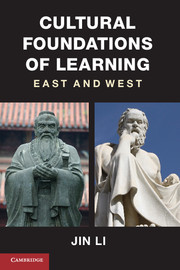Book contents
- Frontmatter
- Contents
- Preface
- 1 Faust and the Birth of a Research Agenda
- 2 Learning to Master the Universe and to Transform Self
- 3 Time Past and Time Present
- 4 Mind-Oriented and Virtue-Oriented Learning Processes
- 5 Curiosity Begets Inquiry and Heart Begets Dedication
- 6 Nerd’s Hell and Nerd’s Haven
- 7 Socratic and Confucian Tutors at Home
- 8 The Devil’s Advocate and the Reluctant Speaker
- 9 Implications for the Changing Landscape of Learning
- Bibliography
- Index
5 - Curiosity Begets Inquiry and Heart Begets Dedication
Published online by Cambridge University Press: 05 June 2012
- Frontmatter
- Contents
- Preface
- 1 Faust and the Birth of a Research Agenda
- 2 Learning to Master the Universe and to Transform Self
- 3 Time Past and Time Present
- 4 Mind-Oriented and Virtue-Oriented Learning Processes
- 5 Curiosity Begets Inquiry and Heart Begets Dedication
- 6 Nerd’s Hell and Nerd’s Haven
- 7 Socratic and Confucian Tutors at Home
- 8 The Devil’s Advocate and the Reluctant Speaker
- 9 Implications for the Changing Landscape of Learning
- Bibliography
- Index
Summary
Affect is involved in learning as in other domains of human life. Affect is not just emotions but also feelings and attitudes, and it is part of our motivational system. Because of its larger scope, I use the term affect instead of emotion. Still, emotions make up the core of our affective life in general and are important in our learning. In this chapter, I first introduce the general concept of emotion followed by a description of research on the kinds of emotions and other affects that Western and Asian learners experience. Then I discuss how affects may function in these learners’ respective learning.
EMOTION IN GENERAL
Emotions are part of our response system to the environment. They have physiological responses such as heartbeat, perspiration, body temperature (e.g., blushing), and involuntary facial expressions (e.g., crying for sadness and smiling for happiness); feelings and attitudes, however, may not have clear physiological responses. For example, we may feel strange in a place with which we are not familiar, or we may feel generally out of sorts, but such feelings are not necessarily accompanied by notable physiological responses. As for an attitude, we may feel that we are entitled to a higher pay than we actually receive, but have no bodily manifestations of this attitude.
- Type
- Chapter
- Information
- Cultural Foundations of LearningEast and West, pp. 153 - 186Publisher: Cambridge University PressPrint publication year: 2012



